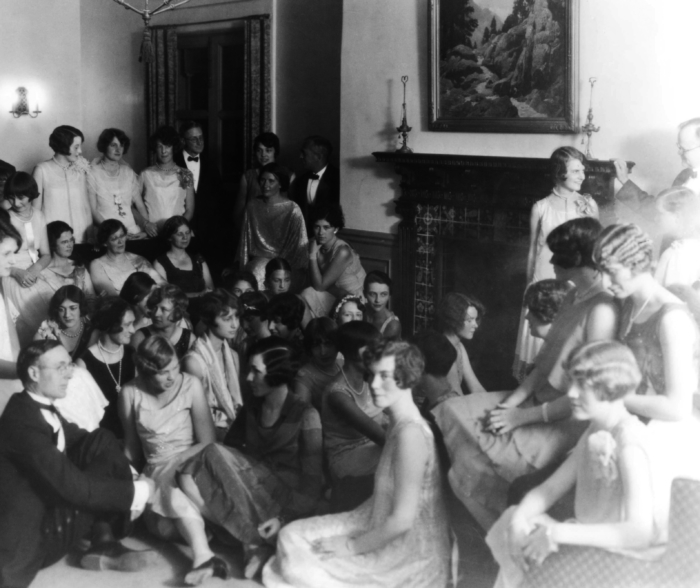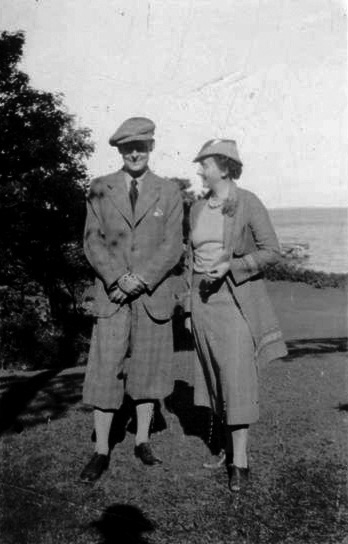
A formal event in the Toll Hall living room, c. 1930s
T.S. Eliot hated California. In a series of private letters written in early 1933, he called it “a horrible place,” “a nightmare,” and one of America’s “two great mistakes” (the other being New York). Eliot’s correspondents were, not surprisingly, British—and the missives may be partly indicative of the poet’s longing for England, after nearly a year abroad, rather than of full-hearted contempt for California. At the very least, there was one thing about California that he was sincerely devoted to.
From late September 1932 until late June 1933, the poet served as a visiting professor at Harvard University in Cambridge, Massachusetts, and a guest lecturer at several other East Coast schools. In the middle of that year, he traveled west—making stops in St. Louis (his birthplace), Minneapolis, and Claremont, California.Eliot had been planning his trip to the West Coast for months. In early 1932, he wrote that he saw this as his “only opportunity” to “explore America.” As the trip drew closer, he hinted that he had a more specific reason for going to California.
We now know that Eliot made the journey primarily to see his friend, Emily Hale, the new drama teacher at Scripps. Eliot and Hale first met in 1912, when he was a graduate student at Harvard University and she was teaching drama at local colleges. In spring 1914, Eliot professed his love to her. According to the poet’s own account, Hale made it clear that she did not share his feelings. A year later, in London, Eliot married Vivienne Haigh-Wood and resolved to settle permanently in the United Kingdom. His correspondence with Hale ceased until the late 1920s, by which time the poet’s marriage was a disaster.

T. S. Eliot and Emily Hale, 1936
In late December 1932, the famously staid poet boarded a train from Boston to Southern California. Officially, he was a renowned scholar accepting an invitation to give a paid lecture at a liberal arts college. Unofficially, perhaps, he was a spirited romantic chasing a long-lost love. Eliot arrived on the platform of the newly built, Spanish-style depot in Claremont at 6:20 a.m. on December 27. Hale was there waiting for him, alongside fellow Scripps faculty member Paul Havens, who had previously met the poet at Oxford University and who (more importantly) owned a car that could deliver him to his lodgings.
While in Claremont, Eliot made multiple visits to the Scripps campus, where he inscribed copies of his newly published play, Sweeney Agonistes, attended several classes, including one on 17th-century literature taught by Havens, and gave an informal talk in the Toll Hall Browsing Room. Hale was, at the time, the head of Toll, which perhaps explains the choice of location. On January 5, in Balch Hall, Eliot gave a lecture on the English nonsense poets Lewis Carroll and Edward Lear. The fourth volume of The Complete Prose of T. S. Eliot collates several accounts of the lecture. According to one report, “Mr. Eliot came to the conclusion that the greatest poetic art is that which sacrifices the least of the other poetic elements in the approximation toward the condition of music.” A separate account indicates that the poet spoke about a type of musical poetry in which words fail, but meanings still exist. These notes suggest that his masterpiece, Four Quartets, may have been germinating in the poet’s mind during his time in Claremont.
On January 10, Eliot made arrangements to spend his last day in Southern California with Hale alone. Marie McSpadden ’34, a Scripps drama major from nearby Glendale, drove the couple to Balboa Island, where her mother had a summer cottage, so that Eliot and Hale could have some “uninterrupted time” together. McSpadden told Eliot biographer Lyndall Gordon that she took the couple out into Newport Bay on a motorboat, then dropped them off at nearby Corona Del Mar beach. We have no other account of the day, and McSpadden offers the only authentic postscript: When Eliot returned to England, he sent her a copy of his 1930 poem “Marina,” a beautiful and haunting rumination on death and rebirth.
Eventually, Hale donated her letters from Eliot to Princeton University, with the stipulation that they must not be read until January 1, 2020. In just two years, we may learn more about what happened between the Scripps professor and the poet during the winter of 1933.

